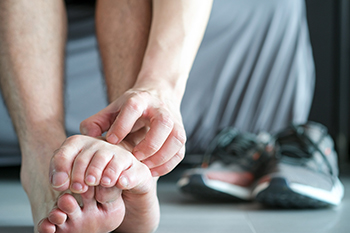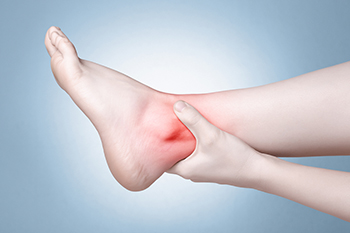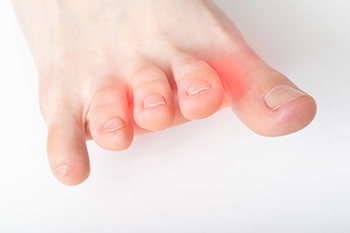Items filtered by date: January 2022
When Ankle Pain is Severe
While severe ankle pain is most typically caused by fractures and sprains, it may also be the result of a ruptured Achilles tendon. An ankle fracture is a break in one or more of the three bones of the ankle. Along with intense and immediate pain, a severe ankle fracture may be accompanied by bruising, swelling, tenderness, difficulty bearing weight or walking, and an obvious deformity. An ankle sprain occurs when one or more ligament that supports the ankle becomes overly stretched, or partially/fully torn. When you severely sprain your ankle, you may experience many of the same symptoms as an ankle fracture, and you may even hear a popping sound at the moment of injury. An Achilles tendon rupture occurs when this large tendon that attaches the calf muscles to the heel bone tears partially or is fully torn away from the heel bone. This condition typically causes severe pain, swelling, stiffness, weakness, bruising, tenderness and an inability to stand your toes. If you have suffered one of these injuries or are experiencing any pain in your ankle, it is suggested that you seek immediate treatment from a podiatrist.
Ankle pain can be caused by a number of problems and may be potentially serious. If you have ankle pain, consult with Sarah Urton, DPM from Kitsilano Foot and Ankle Clinic. Our doctor will assess your condition and provide you with quality foot and ankle treatment.
Ankle pain is any condition that causes pain in the ankle. Due to the fact that the ankle consists of tendons, muscles, bones, and ligaments, ankle pain can come from a number of different conditions.
Causes
The most common causes of ankle pain include:
- Types of arthritis (rheumatoid, osteoarthritis, and gout)
- Ankle sprains
- Broken ankles
- Achilles tendinitis
- Achilles tendon rupture
- Stress fractures
- Bursitis
- Tarsal tunnel syndrome
- Plantar fasciitis
Symptoms
Symptoms of ankle injury vary based upon the condition. Pain may include general pain and discomfort, swelling, aching, redness, bruising, burning or stabbing sensations, and/or loss of sensation.
Diagnosis
Due to the wide variety of potential causes of ankle pain, podiatrists will utilize a number of different methods to properly diagnose ankle pain. This can include asking for personal and family medical histories and of any recent injuries. Further diagnosis may include sensation tests, a physical examination, and potentially x-rays or other imaging tests.
Treatment
Just as the range of causes varies widely, so do treatments. Some more common treatments are rest, ice packs, keeping pressure off the foot, orthotics and braces, medication for inflammation and pain, and surgery.
If you have any questions, please feel free to contact our office located in Vancouver, BC . We offer the newest diagnostic and treatment technologies for all your foot care needs.
Signs of Athlete’s Foot
 Athlete’s foot is a fungal infection on the feet that causes a red, scaly and itchy rash between the toes. The skin may form blisters, as well as crack and peel. The fungus that causes Athlete’s foot is very contagious and thrives in warm and moist environments like showers, locker rooms and pools. It often spreads from the floors, towels, or clothing. Athlete’s foot can spread around the feet as well. If it isn’t treated properly, Athlete’s foot can spread to the toenails, causing them to be thick and discolored, and it can spread to the hands if touched. Patients who believe that they have Athlete’s foot should make sure to keep their feet dry and not share any common items like shoes, socks and towels because of how contagious it is. Patients who believe that they have Athlete’s foot should consult with a podiatrist for a proper diagnosis and treatment path.
Athlete’s foot is a fungal infection on the feet that causes a red, scaly and itchy rash between the toes. The skin may form blisters, as well as crack and peel. The fungus that causes Athlete’s foot is very contagious and thrives in warm and moist environments like showers, locker rooms and pools. It often spreads from the floors, towels, or clothing. Athlete’s foot can spread around the feet as well. If it isn’t treated properly, Athlete’s foot can spread to the toenails, causing them to be thick and discolored, and it can spread to the hands if touched. Patients who believe that they have Athlete’s foot should make sure to keep their feet dry and not share any common items like shoes, socks and towels because of how contagious it is. Patients who believe that they have Athlete’s foot should consult with a podiatrist for a proper diagnosis and treatment path.
Athlete’s Foot
Athlete’s foot is often an uncomfortable condition to experience. Thankfully, podiatrists specialize in treating athlete’s foot and offer the best treatment options. If you have any questions about athlete’s foot, consult with Sarah Urton, DPM from Kitsilano Foot and Ankle Clinic. Our doctor will assess your condition and provide you with quality treatment.
What Is Athlete’s Foot?
Tinea pedis, more commonly known as athlete’s foot, is a non-serious and common fungal infection of the foot. Athlete’s foot is contagious and can be contracted by touching someone who has it or infected surfaces. The most common places contaminated by it are public showers, locker rooms, and swimming pools. Once contracted, it grows on feet that are left inside moist, dark, and warm shoes and socks.
Prevention
The most effective ways to prevent athlete’s foot include:
- Thoroughly washing and drying feet
- Avoid going barefoot in locker rooms and public showers
- Using shower shoes in public showers
- Wearing socks that allow the feet to breathe
- Changing socks and shoes frequently if you sweat a lot
Symptoms
Athlete’s foot initially occurs as a rash between the toes. However, if left undiagnosed, it can spread to the sides and bottom of the feet, toenails, and if touched by hand, the hands themselves. Symptoms include:
- Redness
- Burning
- Itching
- Scaly and peeling skin
Diagnosis and Treatment
Diagnosis is quick and easy. Skin samples will be taken and either viewed under a microscope or sent to a lab for testing. Sometimes, a podiatrist can diagnose it based on simply looking at it. Once confirmed, treatment options include oral and topical antifungal medications.
If you have any questions, please feel free to contact our office located in Vancouver, BC . We offer the newest diagnostic and treatment technologies for all your foot care needs.
Arthritis Can Cause Pain in the Feet and Ankles
When It Feels Like You Are Walking on a Pebble
When a digital nerve leading to the toes becomes repetitively irritated, thickened scar tissue can form around it—entrapping the nerve and causing pain or numbness in the ball of the foot, or the feeling that you are walking on a marble or pebble. This condition is known as Morton’s neuroma—a condition named after a 19th-century American surgeon, Thomas George Morton. Morton’s neuroma most commonly occurs between the third and fourth toes, although it can also affect the nerve running between the second and third toes. Morton’s neuroma can often be caused by wearing shoes that are narrow or tight in the toe box and squeeze the toes together. A podiatrist may treat Morton’s neuroma with a variety of methods to offload pressure on the irritated nerve, along with icing and resting, custom orthotics and shoe modifications, and anti-inflammatory medications. In some cases, surgery may be necessary to relieve pain and help the nerve to heal.
Morton’s neuroma is a very uncomfortable condition to live with. If you think you have Morton’s neuroma, contact Sarah Urton, DPM of Kitsilano Foot and Ankle Clinic. Our doctor will attend to all of your foot care needs and answer any of your related questions.
Morton’s Neuroma
Morton's neuroma is a painful foot condition that commonly affects the areas between the second and third or third and fourth toe, although other areas of the foot are also susceptible. Morton’s neuroma is caused by an inflamed nerve in the foot that is being squeezed and aggravated by surrounding bones.
What Increases the Chances of Having Morton’s Neuroma?
- Ill-fitting high heels or shoes that add pressure to the toe or foot
- Jogging, running or any sport that involves constant impact to the foot
- Flat feet, bunions, and any other foot deformities
Morton’s neuroma is a very treatable condition. Orthotics and shoe inserts can often be used to alleviate the pain on the forefront of the feet. In more severe cases, corticosteroids can also be prescribed. In order to figure out the best treatment for your neuroma, it’s recommended to seek the care of a podiatrist who can diagnose your condition and provide different treatment options.
If you have any questions, please feel free to contact our office located in Vancouver, BC . We offer the newest diagnostic and treatment technologies for all your foot care needs.
Plantar Fasciitis Prevention
 Plantar fasciitis is one of the most common foot injuries and the most frequent cause of heel pain. This condition occurs when the plantar fascia, a ligament that runs along the bottom of the foot, becomes inflamed usually due to repetitive stress and overuse. When the plantar fascia is injured, you may feel a sharp, stabbing pain in your heel and have pain in the arch of the foot. The pain is often at its worst when you take your first few steps in the morning or after a long rest. Fortunately, plantar fasciitis is both treatable and preventable. To prevent plantar fasciitis, it is suggested that you wear comfortable, well-fitted, supportive shoes, rest your feet after a workout or after standing for an extended amount of time, and stretch your feet regularly. If you are suffering from heel pain, don’t hesitate to schedule an appointment with a podiatrist near you.
Plantar fasciitis is one of the most common foot injuries and the most frequent cause of heel pain. This condition occurs when the plantar fascia, a ligament that runs along the bottom of the foot, becomes inflamed usually due to repetitive stress and overuse. When the plantar fascia is injured, you may feel a sharp, stabbing pain in your heel and have pain in the arch of the foot. The pain is often at its worst when you take your first few steps in the morning or after a long rest. Fortunately, plantar fasciitis is both treatable and preventable. To prevent plantar fasciitis, it is suggested that you wear comfortable, well-fitted, supportive shoes, rest your feet after a workout or after standing for an extended amount of time, and stretch your feet regularly. If you are suffering from heel pain, don’t hesitate to schedule an appointment with a podiatrist near you.
Plantar fasciitis is a common foot condition that is often caused by a strain injury. If you are experiencing heel pain or symptoms of plantar fasciitis, contact Sarah Urton, DPM from Kitsilano Foot and Ankle Clinic. Our doctor can provide the care you need to keep you pain-free and on your feet.
What Is Plantar Fasciitis?
Plantar fasciitis is one of the most common causes of heel pain. The plantar fascia is a ligament that connects your heel to the front of your foot. When this ligament becomes inflamed, plantar fasciitis is the result. If you have plantar fasciitis you will have a stabbing pain that usually occurs with your first steps in the morning. As the day progresses and you walk around more, this pain will start to disappear, but it will return after long periods of standing or sitting.
What Causes Plantar Fasciitis?
- Excessive running
- Having high arches in your feet
- Other foot issues such as flat feet
- Pregnancy (due to the sudden weight gain)
- Being on your feet very often
There are some risk factors that may make you more likely to develop plantar fasciitis compared to others. The condition most commonly affects adults between the ages of 40 and 60. It also tends to affect people who are obese because the extra pounds result in extra stress being placed on the plantar fascia.
Prevention
- Take good care of your feet – Wear shoes that have good arch support and heel cushioning.
- Maintain a healthy weight
- If you are a runner, alternate running with other sports that won’t cause heel pain
There are a variety of treatment options available for plantar fasciitis along with the pain that accompanies it. Additionally, physical therapy is a very important component in the treatment process. It is important that you meet with your podiatrist to determine which treatment option is best for you.
If you have any questions, please feel free to contact our office located in Vancouver, BC . We offer the newest diagnostic and treatment technologies for all your foot care needs.



